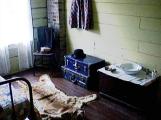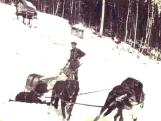14
Father Nicholas CoccolaPat Huble was said to have reminisced about Father Nicholas Coccola, pictured here . She remembered that he was like part of the Huble family for a number of years. She also mentioned that he periodically lived in a cabin at the Giscome Portage homestead. When there, he worked with the First Nations above the homestead on the upper Fraser River. Father Coccola had some medical knowledge and became a friend of the white and Native people alike. He ate meals with the Huble family on numerous occasions. In addition to his medical knowledge, Father Coccola was of course also known for both his spiritual and educational work. He arrived in the New Caledonia area at Fort St. James in 1905 where he succeeded Father Morice.
Father Coccola was greatly beloved by the native people. He visited the native people quite regularly until 1914, when the village was moved to Shelley. Following which, his bi-annual visits were made outstanding events with a volley of musket and rifle fire and every native person in the village lining the riverbank to welcome him. In his book, "A Cross in the Wilderness", Cronin writes, that many people had thought that Father Coccola must have had formal training because he was so efficient at being a dentist, surgeon, midwife and doctor. It is said, "for tooth pulling, he used the only anesthetic available. He would knock the patient senseless with a good blow to the jaw, pull the tooth, then douse him with cold water to bring him around again".
15
This bedroom was one of four used for travelers who were passing through the Giscome Portage.2003
Huble Homestead/Giscome Portage on the Fraser River, North of Prince George, British Columbia, Canada

16
This bedroom was used for travelers who were passing through the Giscome Portage. Of the four bedrooms upstairs, two were used frequently for this purpose. When Al Junior was born in 1918, he was given the northeast upstairs bedroom; however, when many guests arrived, the children were moved around to accommodate the boarders.17
This First Nation woman is Six Mile Mary who was often in Fort George (B.C. Archives H - 07250),1914
Prince George, British Columbia, Canada

18
This First Nation woman is Six Mile Mary who was often in Fort George , including this day of July 30, 1914. Annie Huble often picked the local berries with a number of First Nations women. The berries were then canned for later use at the Huble house where they would be served to the family and the many boarders who stayed at the house on their way to and from the Peace River area.19
Ed Seebach, Al Huble's Business Partner.(Fraser Fort George Museum P993.11.2.76)1912
Prince George, British Columbia, Canada

20
Edward Andrew SeebachEd Seebach pictured here was Al Huble's partner. The two started their business at the Giscome Portage in the year 1904. Ed was of German descent and he was from Kitchener, Ontario. Sam Huble (Al Huble's son) described Ed as tough, "Seebach was tough. He could hike 50 to 60 miles in a day." Sam also mentioned that Ed remained a bachelor his whole life.
Audio clip
Sam Huble, June 1, 1977
"when he fell , his shirt caught on fire --------- ladder a bucket of water. When he fell broke his knee bone, had to bring him in with the dog team ------- and they cut his leg off ------ Dr. Lang [saw him]
Did the store actually ------"
Tragically, Ed fell from a ladder in 1931 when he attempted to extinguish a fire at the McLeod Lake store where he lived. Ed sustained third degree burns and multiple fractures to one of his legs, which later had to be amputated. Following that accident, Ed was never the same and about a year later he passed away.
Edward Andrew Seebach passed away in Prince George on February 27, 1932 at the age of 46. The Prince George Citizen ran the following article in its March 3rd, 1932 edition, concerning Ed Seebach's funeral.
"The funeral of the late Edward Andrew Seebach took place Tuesday afternoon from the Connaught Hill Lutheran church, the services being conducted by Rev. Erich Hopka. The pall-bearers were all old-time friends of the deceased. Herbert Porter, A.B. Moffat, L.C. Gunn, George Kennedy, Jack McGaghran and E.H. Burden.
In the death of "Ed" Seebach this section of Cariboo lost one of its colorful personalities who was born in Ontario 46 years ago of German parents, and arrived in this section of the province about 1906, where he entered into partnership with A.J. Huble, and engaged in farming, trapping and trading. For many years the firm Seebach & Huble was one of the best known fur and trading concerns in the district.
….Mr. Seebach was operating a store at McLeod, on the lake of the same name, when his mind became deranged and he was brought in to the city hospital on Thursday last, where he died on Sunday. About a year ago he met with a serious accident, while attempting to extinguish a fire on the roof of his store, he fell from a ladder and received such injuries to one of his legs that the amputation of the member later became necessary. He appeared to regain his strength, and the news that his mind had become affected came as a marked shock to his many friends."
22
Trapping began in the late fall and continued through the winter. Transportation over the trapline and freighting furs always involved snowshoes, dogs, and sleds.The headlines of the Saturday October 30th , 1915 Prince George Herald read, "FUR BUSINESS PROMISES TO YIELD GOOD PROFITS". This article spoke of how the fur industry of Canada was one of the greatest resources of the country, supplying the market economy of the world's fashion industry with the furs it required. There was much talk of how the fur bearing animals were becoming extinct, due to over-harvesting by the fur industry. However, this newspaper article in the Prince George Herald denied that claim, and promised a good year for the trappers in New Caledonia.
23
Eldest daugher Bertha Huble (ca. 1932), wearing a fur coat possibly made for Annie in 19151932
Prince George, British Columbia, Canada

24
Bertha Huble, the eldest daughter of Al and Annie Huble (circa 1932), wearing a fur coat. This fur coat may be the one Al had made for his wife Annie in 1915. Or, Bertha's father Al, may have had this coat made for his daughter from furs that he had trapped later on.The excerpt below is from Al Huble's diary, January 8, 1915
[Al indicated the number 12 over the word skin as if it would take 12 skins to make the coat.]
$75.00 Large 12 skin coat. ladies. beaver.
20 small skins.
Collar 4 small mink.
Cuffs 2 small mink.
Muff 6 large 10 small
Hat 5 small
Bust, Hips, Length, Sleeve length.
He has a little diagram as if he was measuring a bent arm.
Man's Coat 12 skins. plucked. $70
25
The Herald remarked on the growing fur market in this November 1915 article1915
Huble Homestead/Giscome Portage Society Archives, Prince George, British Columbia, Canada

26
"Went across the river. set two linx [sic] traps. Ed W. River. [Ed went to Willow River] Cold day." from Al Huble's diary November 28, 1915This November 27th, 1915 article from the Prince George Herald remarked on the growing market for furs in the fashion industry in North America. The writer commented on the bright future that the American trapper could look forward to when World War II would end. There was a high demand for fur over garments from the fashion minded men and woman of this country according to this piece in the paper.
Ed Seebach and Albert Huble both trapped from the time they arrived in the Giscome Portage area about 1904, until many years later. It appears the two men did quite well at this part of their business, as Al discloses in his diaries of 1909 to 1919.
In the year 1915, Al describes in his diary how many furs it would take to make a ladies size 12 fur coat. He appeared to be having a fur coat made of beaver, with a mink collar and cuffs for his wife Annie Huble. Annie would have needed a warm coat for the northern climate they lived in. It was cold in the Prince George area, sometimes dipping down to 25 degrees below zero (Celsius). Mrs. Huble had fashion savvy in her time, so she would have known that a ladies wardrobe was not complete without a good fur coat.
27
Al Huble on the trap line with a team of dogs in the winter of 1912.1912
Fraser-Fort George Region, Prince George Area British Columbia, Canada

